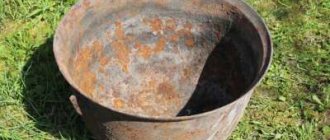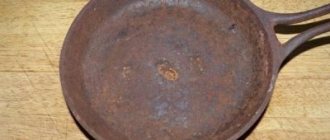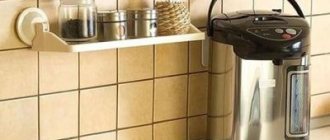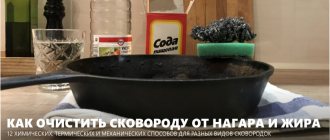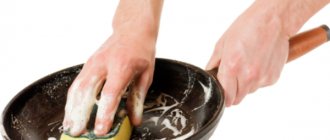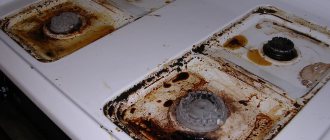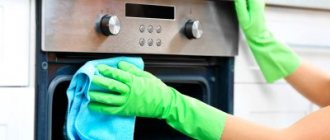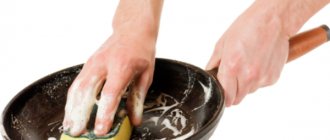Such frying pans are durable, they are used from generation to generation, but they also have a significant drawback - a tendency to form carbon deposits. The older the kitchen utensils, the thicker the layer of soot on them.
It will not be possible to remove it with a sponge and classic dishwashing detergent. Read the article about how to clean a cast-iron frying pan from black deposits at home and prevent its reappearance.
How to remove using folk remedies?
You don't have to go to the store to remove carbon deposits from a cast iron frying pan. Substances that effectively remove a layer of hard soot are found in every home. You can cope with the problem using a mixture based on water, table vinegar and soda.
Procedure:
water and vinegar are mixed in equal proportions;- pour the solution into the frying pan and place it on the stove;
- when the product boils, part of the carbon will move away from the surface;
- turn off the gas and add 2 tablespoons of soda - after its introduction, a reaction will begin in the form of the release of gas bubbles, this will enhance the effect;
- leave the solution in the pan for another hour;
- Drain the liquid and rinse the dishes with clean water several times.
If carbon deposits remain on the surface, it must be cleaned with dry soda and the back of a sponge.
Do not pour too much water into the pan . As the soda and vinegar interact, it will bubble and may overflow.
You can deal with carbon deposits using laundry soap and soda. This mixture will help get rid of even a thick, old layer of burning.
Procedure:
- Laundry soap is grated or chopped with a knife. To clean the pan you will need a whole block.
- Pour 8 liters of water into a large enamel basin and bring it to a boil.
- Pour the prepared soap into the boiling liquid and add half a glass of soda ash. The solution must be stirred until all components are completely mixed.
- Lower the frying pan into the basin and leave for 2 hours. You need to boil it over low heat, periodically adding water, which will evaporate.
- After 2 hours, turn off the fire and leave the dishes to soak until the solution has cooled.
- When the liquid reaches room temperature, it is drained. Wash the pan in plenty of clean water. Soft deposits are cleaned off with a regular brush.
Boiling the solution is only permissible in a well-ventilated area. The accumulation of fumes can lead to headaches and cause irritation of the mucous membranes.
You can get rid of carbon deposits mechanically. It involves calcining the dishes in the oven.
Procedure:
The bottom of the oven is covered with a layer of foil to collect carbon deposits;- place the frying pan on the grate - it should be positioned bottom up;
- the oven is turned on at full power;
- leave the pan to “bake” for 3 hours;
- turn off the gas and allow the dishes to cool naturally;
- rinse the product with plenty of water, clean with a brush;
- foil with pieces of burning is simply thrown away.
Calcination is the least labor-intensive method of dealing with soot. It just takes time.
A cast-iron frying pan that has been burnt while cooking outdoors is cleaned with sand . It is rubbed until the surface of the dish is clear of carbon deposits.
How to remove with special preparations?
There are compositions on sale that can be used to quickly and effectively remove carbon deposits from a cast iron frying pan. Top 3 best products:
Cleaner Dr. Beckmann
The gel is suitable for caring not only for metal, but also for enamel surfaces . Allows you to cope with a layer of burning and old fat. The product is convenient to apply, as it is bottled with a sprayer. Price – 345 rubles. Read reviews here, here and here.
Cream Brand
It can only be used on the outer surface of the frying pan, since in addition to the surfactant, it contains alkali. Price – 100 rubles. Read reviews here and here.
Universal spray Freshbubble
The advantage of this product is its safe composition, thanks to which the frying pan can be treated not only from the inside, but also from the outside. Price – 230 rubles. Read reviews here and here.
When choosing a cleaning product, you need to consider the following recommendations:
- If the layer of burning is old and has accumulated on the frying pan for years, then it will not be possible to get rid of it with classic cleaning compounds. Foaming gels for removing grease from dishes are only suitable for dealing with fresh stains.
- When buying specialized chemicals, you need to pay attention to its composition. It should not contain components that can harm human health. You should not choose products that are not intended for cleaning dishes.
- The use of alkaline compounds, for example, for flushing drains, is permissible only for the outer surface of the frying pan. Contact of alkali on the working side of the dishes is unacceptable.
- It is better to purchase liquid compositions for cleaning frying pans in bottles with a sprayer. This makes them easier to apply and reduces consumption.
Features of application:
- When working with any chemicals, you need to use gloves;
- if the composition has a strong odor, it is necessary to use a mask or respirator;
- Before the first use, you must carefully study the instructions;
- It is undesirable to mix several cleaning products at once or expose them to heat - this can lead to an unpredictable reaction;
- Substances should be stored out of the reach of children.
Rules for caring for kitchen utensils to prevent the appearance of plaque
To prevent carbon deposits from forming in the frying pan during cooking, it is recommended to calcinate it periodically. To do this, use table salt and 2 tablespoons of sunflower oil.
Procedure:
Place a dry frying pan on the fire.- Wait until the cast iron heats up well.
- Pour salt into the dishes.
- Heat it until it darkens. When heating, the salt must be stirred so that it does not start to burn.
- Remove the pan from the stove and pour the salt into the trash bin.
- Grease the walls of the dish with oil, keep on low heat and let cool.
After such calcination, there is no need to wash the pan; you can immediately cook food on it, it will not burn. In this way, they not only prevent the appearance of carbon deposits, but also restore the coating after the next cleaning. After each use, dishes need to be washed not only from the inside, but also from the outside.
Mechanical methods
In addition to soot, old frying pans can also be covered with rust. But there is no need to rush to throw them away. Even dishes that seem hopeless at first glance, like those in the next photo, can be put in order and used for many more years.
Rusty frying pan
Long-term layers can be removed from it mechanically, and only then use the above methods to bring the matter to fruition. To do this, you can use a metal brush, sandpaper, or remember the experience of our grandmothers and rub the surfaces with sand.
Cleaning the pan with a wire brush
By the way, if you combine the mechanical method with the thermal one and first heat the frying pan filled with sand well over a fire, then it will be easier to clean its inner surface.
But the fastest way to do the job outside is a drill with a special brush attachment.
Cleaning carbon deposits with a drill and a metal brush attachment is as easy as shelling pears
But remember that all these methods leave scratches on the walls. They not only spoil the appearance of the utensils, but also negatively affect the non-stick properties of cast iron: they contain oil and particles of cooking food, which cannot be easily washed off. Therefore, after any cleaning method, the frying pan needs to be updated, trying to at least partially restore its original properties.
What can't be done and why?
You can find recommendations for soaking a frying pan in a solution of washing powder , silicate glue and other chemicals. Their use for processing utensils that come into contact with food is unacceptable, as it risks food poisoning. Such compositions can only be used to clean the outside of the pan.
It is not recommended to soak cast iron cookware for longer than 2 hours. Due to prolonged contact with moisture, rust may appear on it.
To combat carbon deposits, there is no point in putting the pan in the dishwasher. She will not be able to cope with a thick layer of burning.
Features of cast iron cookware
Production occurs by alloying iron with carbon. Silicon, manganese and sulfur can be added here. Even in ancient times, cast iron gained universal recognition. Today, this proven type of product is also trusted.
Cast iron is used to make pots, cauldrons, etc. of various sizes and variations.
There are often two types of cast iron cookware - with and without enamel coating. In the first case, there are much more prospects: a more advanced non-stick effect, no risk of rapid rust (with constant moisture). Another important feature is the large assortment. Pots, cauldrons and other utensils of various sizes and variations are available to you.
Helpful information
Tips for dealing with carbon deposits formed on a cast iron frying pan:
After using any chemicals, dishes must be washed thoroughly. If they enter the body with food, they can lead to serious consequences.- Metal scrapers and brushes can be used to remove carbon deposits.
Cast iron is not afraid of contact with hard surfaces. However, you don’t need to press the brush too hard to avoid causing deep scratches. - Before you start cleaning, you need to remove the detachable elements from the pan. Cookware with a plastic handle cannot be heated.
- Abrasives should only be used as needed. If the deposit is not too dense and old, it is better to resort to the help of a gel.
Read about methods and means of cleaning frying pans made from various materials in this section.
Creating a non-stick coating
After intensive cleaning, cast iron resembles skin after peeling. Women will understand what this means. This is a porous material that suffers not only from mechanical, but also from chemical influence, so it needs to be helped to recover.
After the simple procedure described below, your frying pan will not only regain its former shine, but will also receive a kind of non-stick coating that will protect it from the formation of new soot.
Step 1.
Pour salt into a frying pan and heat it over the fire.
Salt is heated in a frying pan
Step 2.
Pour out the salt, brush off the residue from the walls, and thickly grease the cooled dishes on all sides with vegetable oil.
Surface treatment with oil
Step 3.
Place it in an oven preheated to 180-200 degrees for an hour.
Keep the frying pan in the oven for an hour
. Step 4.
After the dishes have cooled, remove any remaining oil with a soft cloth.
Remaining oil is removed with a napkin
Advice. You should do the same with a new, newly purchased cast iron frying pan or Dutch oven before using it for the first time.
The essence of these manipulations is that the pores of cast iron open when heated and absorb oil, which remains sealed in them after cooling. The oil penetrates into scratches and microcracks on the surface, and there is no room left for small particles of food being cooked in the pan, or for moisture. Therefore, food burns less on the bottom and walls, and the formation of soot also slows down.
To prevent its occurrence, the dishes need to be looked after regularly. But remember that cast iron does not like sudden temperature changes, and the created non-stick coating is destroyed by detergents.
Caring for a cast iron frying pan
Therefore, it is better to wash cast iron pans simply with hot water without chemicals. If you can’t do without it, then from time to time the procedure described above must be repeated.
We hope that each of our readers has found in this article a suitable method for cleaning cast iron cookware, and will now cope with this task without problems.
